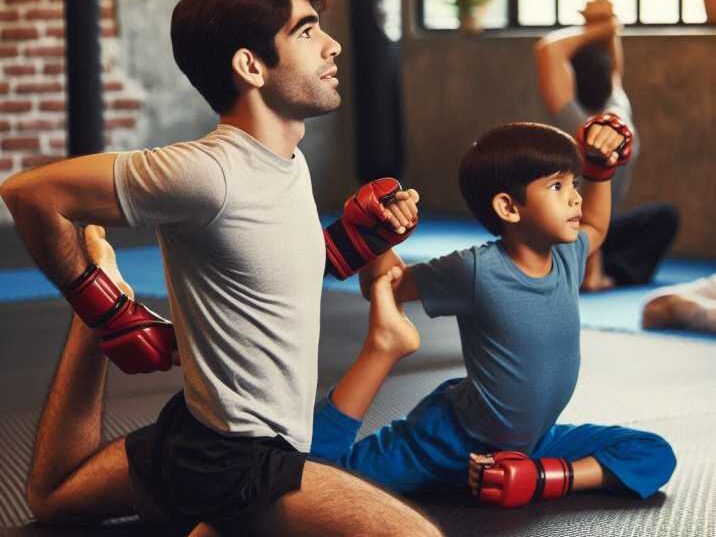Mixed Martial Arts (MMA) is a popular sport that combines different martial arts techniques such as boxing, Brazilian Jiu-Jitsu, Muay Thai, wrestling, and judo. Mixed Martial Arts exercises are an essential part of training for fighters and fitness enthusiasts alike. These exercises help build strength, agility, endurance, and discipline. This article will explore various mixed martial arts exercises and explain how they can benefit both kids and adults. We will also discuss how training in MMA can improve focus, especially in school and other activities, due to its demand for concentration and discipline.
Introduction to Mixed Martial Arts Exercises
Table of Contents
Mixed Martial Arts (MMA) exercises are specialized workouts designed to prepare fighters for the unique demands of the sport. These exercises enhance skills such as striking, grappling, and ground fighting, combining elements from multiple martial arts disciplines. For those looking to improve their physical fitness, incorporating MMA exercises into a workout routine can offer numerous benefits, including improved strength, flexibility, balance, and cardiovascular health.
MMA training also teaches valuable life skills, such as discipline and focus. These skills are crucial in various aspects of life, including school and personal development. For students, the concentration and dedication learned in MMA training can translate to improved performance in their studies and other activities.
Benefits of Mixed Martial Arts Exercises Explained
Improves Physical Fitness:
- Mixed Martial Arts (MMA) exercises are comprehensive workouts that engage the entire body, enhancing overall fitness levels. These workouts combine various training elements that build muscle strength, improve cardiovascular endurance, and increase flexibility. By incorporating different types of movements and techniques, MMA provides a balanced approach to physical health, helping participants to become stronger, faster, and more agile.
- Strength Training:
MMA incorporates strength-building techniques such as grappling, wrestling, and striking, which help improve muscular strength and endurance. These exercises work multiple muscle groups, enhancing core strength and overall muscle tone, making participants more powerful and resilient. - Cardio Workouts:
Activities like jumping rope, running, and hitting the heavy bag are integral parts of MMA training that significantly boost cardiovascular health. These high-intensity workouts help improve heart and lung function, increase stamina, and reduce the risk of heart-related issues. - Flexibility:
Flexibility is crucial in MMA, where dynamic movements such as kicks and grappling are common. Stretching exercises and these fluid movements help improve flexibility, increase the range of motion, and reduce the risk of injuries, ensuring that participants stay agile and limber.
- Strength Training:
Enhances Mental Focus and Discipline:
- MMA is not just about physical strength; it also requires a high level of mental focus and discipline. Training sessions often involve learning complex combinations and techniques that demand concentration and mental toughness. This rigorous mental training helps sharpen the mind, improve memory, and enhance problem-solving skills.
- Improved Focus in School:
The discipline and concentration developed through MMA training can translate into better focus in school. Students learn to pay closer attention to details, manage their time effectively, and stay committed to their studies, which can lead to improved academic performance. - Better Self-Control:
MMA training teaches participants how to control their impulses and emotions, fostering patience and self-discipline. These skills are invaluable in daily life, helping individuals remain calm under pressure and make thoughtful decisions in challenging situations.
- Improved Focus in School:
Boosts Confidence and Self-Esteem:
Participating in MMA can greatly enhance an individual’s confidence and self-esteem. Learning self-defense techniques empowers people, giving them the assurance that they can protect themselves if necessary. This sense of security is particularly beneficial for children who might feel shy or lack confidence.
- Self-Defense Skills:
Knowing how to defend oneself effectively provides a significant confidence boost. It helps individuals feel safer and more secure in their daily lives, reducing anxiety and enhancing their ability to handle stressful situations. - Positive Self-Image:
Achieving fitness goals and mastering various MMA techniques contributes to a positive self-image. As participants see their progress, they develop a stronger sense of self-worth and accomplishment, which is vital for overall well-being.
Teaches Teamwork and Communication:
Many MMA exercises require participants to work with a partner, fostering teamwork and communication skills. Through partner drills and sparring, individuals learn to cooperate, trust, and communicate effectively, which are essential skills in both personal and professional lif
- Partner Drills:
Drills that involve sparring and grappling require cooperation and effective communication between partners. These activities teach participants how to work together towards a common goal, improving their ability to collaborate in other areas of life. - Supportive Environment:
Training in an MMA class often takes place in a team setting, where participants encourage and support each other. This environment builds a sense of community and belonging, helping individuals develop social skills and form lasting friendships.
Provides a Healthy Outlet for Energy:
- MMA exercises offer a productive way for children and teens to channel their energy. Engaging in physical activity helps reduce negative behaviors such as aggression or hyperactivity, while promoting positive social interactions and friendships.
- Stress Relief:
Physical exercise, such as MMA training, is an excellent way to relieve stress and improve mood. The release of endorphins during workouts helps reduce stress levels, combat anxiety, and promote a sense of well-being. - Healthy Habits:
Encouraging regular exercise from a young age fosters lifelong healthy habits. MMA training instills a routine of physical fitness, teaching participants the value of staying active and maintaining a balanced lifestyle for long-term health.
- Stress Relief:
Popular Mixed Martial Arts Exercises
1. Striking Drills
Striking drills focus on improving punches, kicks, elbows, and knees. These drills are essential for developing speed, accuracy, and power in striking techniques.
- Punching Drills: Practicing jabs, crosses, hooks, and uppercuts on a heavy bag or mitts improves hand speed and power.
- Kicking Drills: Roundhouse kicks, front kicks, and side kicks help improve leg strength and flexibility.
- Knee and Elbow Strikes: Practicing knee and elbow strikes on pads helps develop close-range striking power.

2. Grappling Exercises
Grappling exercises are fundamental in MMA training as they help fighters control their opponents on the ground.
- Takedown Drills: Practicing single-leg and double-leg takedowns helps improve balance and agility.
- Submission Drills: Learning techniques like arm bars, guillotine chokes, and rear-naked chokes are crucial for winning matches on the ground.
- Position Drills: Practicing dominant positions like mount, guard, and side control helps fighters maintain control over their opponents.
3. Conditioning Workouts
Conditioning is a critical aspect of MMA training that focuses on building endurance and stamina.
- Circuit Training: A combination of different exercises performed back-to-back with minimal rest, such as push-ups, sit-ups, squats, and burpees.
- Plyometrics: Exercises like jump squats and box jumps that improve explosive power.
- Cardio Workouts: Running, swimming, or cycling to build cardiovascular endurance.
4. Flexibility and Mobility Training
Flexibility and mobility are vital for MMA fighters to perform techniques effectively and avoid injuries.
- Dynamic Stretching: Involves moving parts of your body and gradually increasing reach, speed, or both.
- Static Stretching: Holding stretches like hamstring stretches or shoulder stretches to improve flexibility.
- Yoga and Pilates: Practices that help improve flexibility, core strength, and mental focus.

5. Sparring Sessions
Sparring is a controlled practice fight that allows fighters to apply their skills in a real-time environment.
- Light Sparring: Practicing techniques with a partner using minimal contact to focus on form and technique.
- Heavy Sparring: Full-contact sparring with protective gear to simulate real fight conditions.
- Controlled Sparring: Focuses on specific techniques or scenarios, such as defending against takedowns or working on striking defense.
Training Schedule for Mixed Martial Arts Exercises
| Day | Exercise | Focus |
|---|---|---|
| Monday | Striking Drills, Conditioning Workouts | Speed, Power, Endurance |
| Tuesday | Grappling Exercises, Flexibility Training | Ground Control, Flexibility |
| Wednesday | Sparring Sessions, Conditioning Workouts | Technique Application, Stamina |
| Thursday | Striking Drills, Mobility Training | Technique, Injury Prevention |
| Friday | Grappling Drills, Plyometrics | Strength, Explosive Power |
| Saturday | Circuit Training, Yoga or Pilates | Overall Fitness, Mental Focus |
| Sunday | Rest or Light Activity | Recovery |
Tips for Safe and Effective MMA Training
- Warm Up and Cool Down: Always start with a warm-up to prepare your muscles and end with a cool-down to help your body recover.
- Use Proper Technique: Focus on form and technique to prevent injuries and get the most out of your workouts.
- Stay Hydrated: Drink plenty of water before, during, and after workouts to stay hydrated.
- Listen to Your Body: Rest when needed and avoid pushing too hard to prevent overtraining and injuries.
- Wear Protective Gear: Always wear the appropriate gear, such as mouthguards, gloves, and shin guards, during sparring and heavy bag work.
Conclusion
Mixed Martial Arts exercises offer numerous physical and mental benefits, making them an excellent choice for people of all ages. Whether you’re training to compete or simply looking for a new way to stay fit, incorporating MMA exercises into your routine can help improve strength, flexibility, and mental focus. Moreover, the skills and discipline learned in MMA training can translate to other areas of life, including improved focus and performance in school and daily activities. Remember to practice these exercises safely and consistently to maximize their benefits.
Frequently Asked Questions (FAQs)
1. What are the benefits of Mixed Martial Arts exercises for kids?
Mixed Martial Arts exercises help kids build physical fitness, learn discipline, improve focus, and boost confidence.
2. Can beginners start with MMA exercises?
Yes, beginners can start with basic MMA exercises. It’s important to learn proper techniques from a qualified instructor.
3. How often should I practice MMA exercises?
It is recommended to practice MMA exercises 3-5 times a week, depending on your fitness goals and experience level.
4. Are MMA exercises safe for everyone?
MMA exercises can be safe for people of all ages if done under proper supervision and with the right protective gear.
5. Can MMA training help improve concentration in school?
Yes, the discipline and focus required in MMA training can help improve concentration and performance in school.


